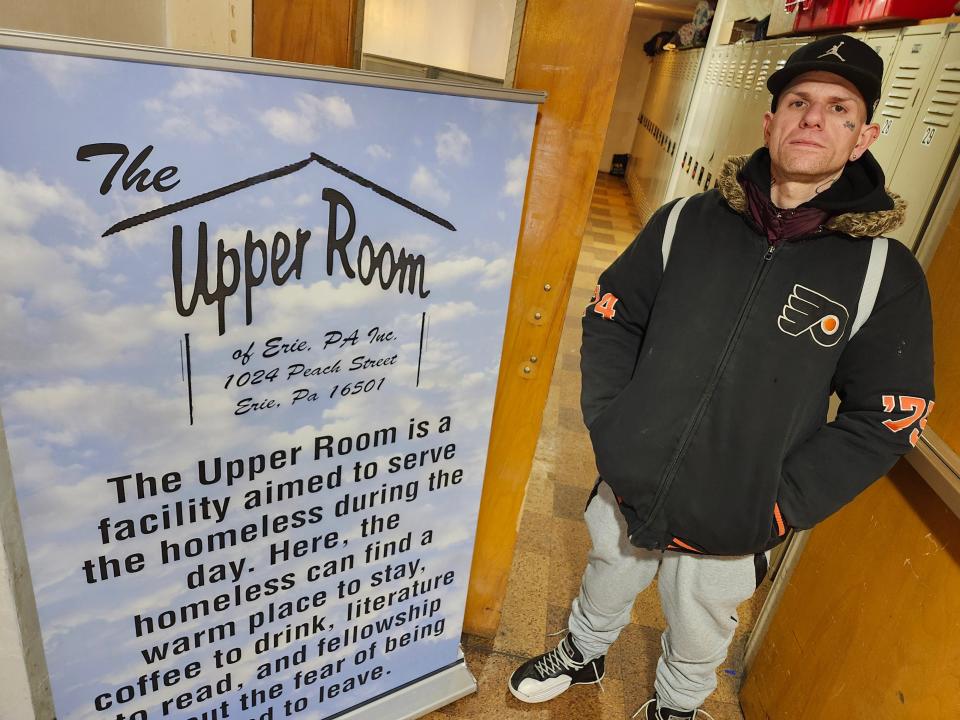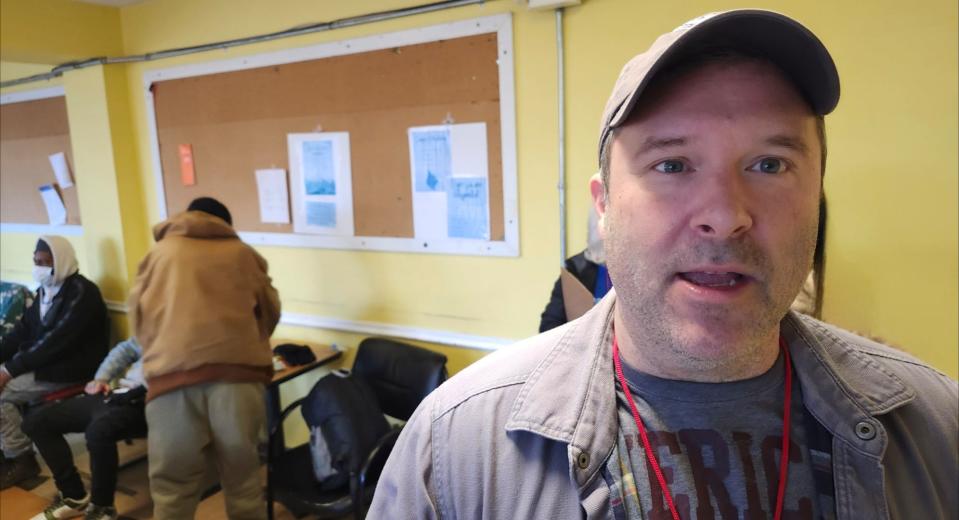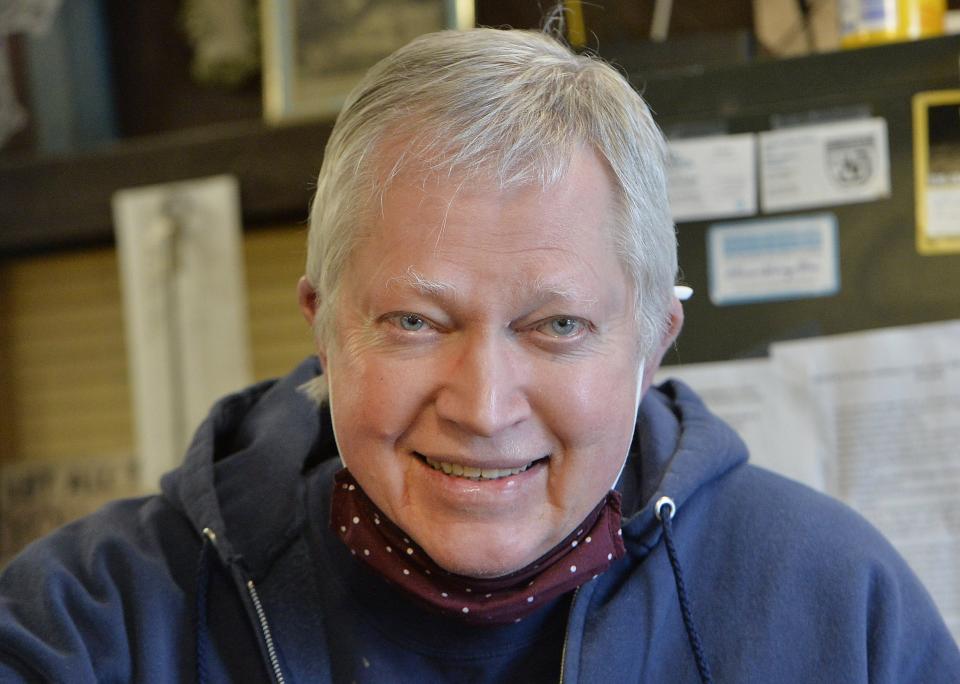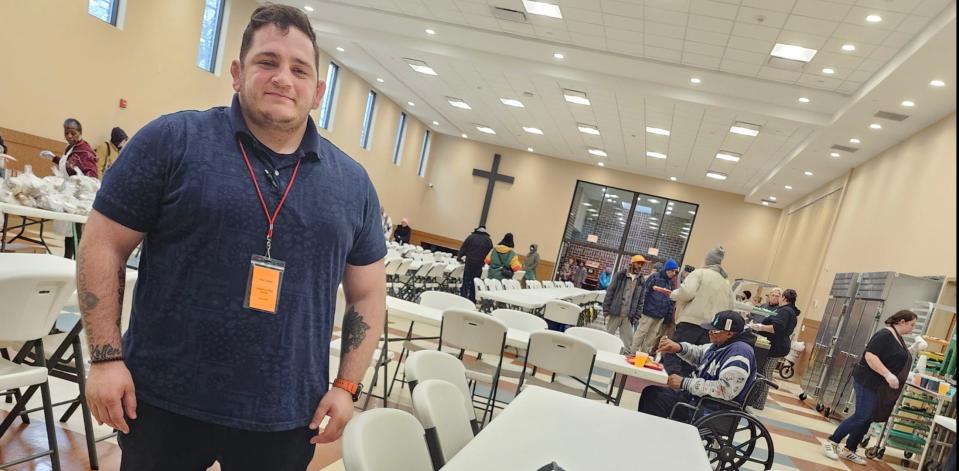'Looking out for us:' yearly Erie-area count sheds light on scope of homelessness
Jonathan Rodriguez-Santiago doesn’t mind answering questions.
Especially when the answers can help bring compassion and context to why he and many others in the Erie region are without permanent homes.

Rodriguez-Santiago, 34, is originally from Puerto Rico. He’s done time in prison and came to Erie in 2008 because he has family here.
A recovering addict, Rodriguez-Santiago says he’s now clean. He currently works at a local manufacturing business.
On the morning of Jan. 26, after spending the night in a local shelter, Rodriguez-Santiago was at the Upper Room daytime homeless shelter, on the second floor of St. Paul’s United Church of Christ, 1024 Peach St., answering questions about his circumstances as part of Erie County’s annual Single Point In Time count of the county’s homeless population.
On Jan. 25 and 26, a team of roughly 25 people, made up of both social services professionals and volunteers, visited homeless shelters, soup kitchens, makeshift encampments and scores of other locations throughout Erie County.
They also dropped off toiletries, winter hats, sleeping bags and other necessities to those they encountered.
The Single Point in Time team’s gentle queries sought names, ages and other details, such as “Do you mind telling us where you slept last night?” to forge an accurate picture of how pervasive homelessness is locally.
Rodriguez-Santiago was among those who provided answers.
“It’s tough out there, but there are no excuses man,” Rodriguez-Santiago said. “I walk everywhere, I do what I have to do, I’m trying to get better with my English."
Rodriguez-Santiago said he has been spending nights at the Erie City Mission/New Life Center, 1017 French St., for the past month.
“I’m trying to make moves and do better for myself,” he said. “I don’t have any problem sharing the information if it’s going to help more people understand what’s going on out there.”
Compassionate data collection
Multiple local agencies are involved in the Single Point In Time Count, mandated each year by the federal Department of Housing and Urban Development, to help local officials get a sense of the overall scope of homelessness in their communities.
Nationwide, communities typically conduct the count in January.
It focuses on getting an estimate of both the Erie-area’s unsheltered homeless population — defined by HUD as someone who frequently takes shelter in a place not meant for human habitation, such as a car, park, sidewalk, abandoned building or on the street — and those who frequent overnight emergency shelters but have no permanent address.
Erie County's results will be released publicly in April.
The most recent count, conducted throughout Erie County in January 2023, identified 688 people in either permanent supportive housing or rapid rehousing programs; 266 people living in emergency shelters; 56 living in transitional housing; 40 people who were unsheltered, and nine people who were in “safe havens,” or a form of supportive housing that serves hard-to-reach homeless persons with severe mental illness, for a total of 1,059 individuals.
George Fickenworth is the assistant director of the Mercyhurst Civic Institute, which coordinates Erie County’s Single Point In Time count. Fickenworth also hit the streets on Jan. 25-26 to talk with homeless residents.

“We collect as much demographics as we can from people, but only what they’re willing to give,” Fickenworth said. “We never press. We ask for names so there’s not duplication and we want to make the best effort we can not to count people twice. If they don’t want to give full names, we’ll take initials. We try to be respectful.”
The Single Point in Time team often asks about prior mental health/substance abuse issues, Fickenworth said, but makes it clear that respondents don’t have to answer if they’re not comfortable doing so.
“It helps us get a sense of the population that we have out there,” Fickenworth said. “Years ago we used to drive around in the middle of the night to find people, like a lot of communities did. Now that we’ve changed to this team approach and we’re out during the day and at night, our unsheltered (homeless) numbers have gone through the roof.”
'The scope of the problem'
Cris Taylor, the Upper Room’s executive director, said there are likely many more uncounted and unsheltered homeless out there.

“It's an estimate," Taylor said of the Point in Time count. "Even in our weather, there are still people living in camps and parking lots and behind buildings... They’re not always easy to find,” Taylor said.
“The count helps us get a sense of the scope of the problem. That’s the important part,” Taylor said. “There is so much need out there.”
Renee Lamis, Mayor Joe Schember’s chief of staff, agrees.
The city is working with various partners, including the Erie Community Foundation, Erie County government and various social service agencies, to create a plan for how to most effectively allocate $2.9 million in American Rescue Plan funds earmarked for assisting the homeless and other vulnerable populations via housing, rental assistance and other services.
That plan has been approved by HUD, and suggests using nearly $2.3 million of those funds to develop affordable, safe housing for chronically homeless individuals.
That would include both Section 8-eligible apartments scattered throughout the city and constructing what Lamis referred to as “a permanent supporting housing complex for those with the biggest needs” at a location that has yet to be determined.
The new facility would house up to 50 people, have a variety of social services available on-site and feature round-the-clock security, Lamis said.
Erie-area officials in 2023 toured a similar housing development in Cleveland, known as Emerald Commons. That complex, which opened in 2006, features 52 housing units for homeless residents.
“We know we have a lot of people who are chronically unhoused with deep service needs,” Lamis said. “They are the ones falling through the cracks because they have no place to go. The count is an important part of the data that we are using to inform our decisions."
Both Fickenworth and Taylor have said that past counts show that the local unsheltered homeless population is growing in Erie.
Lamis said that has spawned complaints from downtown businesses and others about homeless individuals downtown, including panhandling, public urination/defecation and people sleeping on sidewalks, behind buildings, in parking garages or in Perry Square.
The city is sensitive to those concerns, Lamis said, and is working with numerous other groups to find long-term solutions. Further, Erie City Councilwoman Kathy Schaaf has launched a study of the feasibility of creating a number of public restrooms throughout the city, including downtown Erie.
“These are human beings, and they need our help. Locking them up for loitering doesn’t resolve the issue,” Lamis said. “We’re looking at best practices in other communities to find the models that work.”
Opportunity to learn
Jennie Hagerty is the executive director of the Mercy Center for Women, an Erie nonprofit that provides transitional housing for homeless women/children/families affected by substance abuse, domestic violence and other issues.
Hagerty was part of the local Single Point in Time Count team, working at Emmaus Soup Kitchen, 218 E. 11th St., on Jan. 26.
The Mercy Center for Women’s newest transitional housing facility, the Mercy Anchor Community Center, opened in 2023 at the former Holy Rosary School building at 1012 E. 28th St. It features 13 new two-bedroom apartments.
The nonprofit, on Feb. 14, plans to serve soup and bread and pass out snack/hygiene bags to the homeless at Perry Square.
Hagerty called working on the local homeless count “a privilege."
“It’s boots on the ground, hands-on experience," Hagerty said. "We know we don’t have enough facilities or rooms to house all the individuals who need help. And we know some people don’t want to be housed for whatever reasons. But do we have the right systems in place? That’s what all of this helps us find out.”
Hassan R., a 40-year-old Reading, Pennsylvania native, has lived in Erie for the past four years with his wife. They are homeless and often visit the Upper Room shelter during the day.
“It’s great that they want to keep track and see what people out there really need,” he said. “Somebody is looking out for us.”
Personal experience
On Feb. 26, Kane Patron found himself asking questions in a large wooded area owned by CSX Railroad, between Sassafras and Chestnut streets just west of West 14th Street.
Up to two dozen homeless people are believed to live there.
Patron — an emergency shelter director at Community Shelter Services, 655 W. 16th St. — can relate to the struggle to secure permanent housing.
A Mercyhurst University graduate and former wrestler/mixed martial arts fighter, Patron, 30, was homeless and lived in Erie shelters as a teenager.

“We asked them what kinds of supplies they needed and we even dropped off hats and about 20 sleeping bags,” Patron said. “We were able to ask our interview questions... We know we’re dealing with a population where many people have severe mental health issues.”
Patron said his upbringing fuels a passion for this work.
“I grew up in shelters from seventh grade through high school,” Patron said. “There wasn’t anything close to enough homeless support when I was a kid. Seeing all the soup kitchens and shelters and help available now, that makes me feel good.”
Contact Kevin Flowers at kflowers@timesnews.com. Follow him on X at @ETNflowers.
This article originally appeared on Erie Times-News: Why is the yearly count of Erie's homeless so important?

